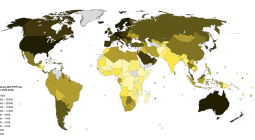This really does change everything: attaining 1.5 °C needs all available mitigation levers

There are multiple ways in which society can theoretically transition from its current carbon-intensive state to a zero-carbon future, ideally fast enough to limit global warming to 1.5 °C above pre-industrial levels. Although the carbon budget associated with this temperature is close to being consumed (IPCC 2021), it still remains achievable—just. Furthermore, we know what needs to be done to achieve it, because we know what contributes to CO2 emissions. We need energy sources, whose carbon content results in emissions. Reducing both our demand for energy and its carbon intensity (by increasing the share of zero-carbon fuels in our energy mix) is thus of paramount importance. Some industrial manufacturing processes, particularly in cement production, produce CO2 as a chemical by-product. Capturing that CO2, finding alternative ways to produce cement, or reducing cement demand, is therefore necessary. Our agriculture, forestry and other land use can be a net source or sink of CO2, so making it a large net sink by enhancing carbon dioxide removals (CDRs), for example through afforestation, would help. And we hope to have available a range of human-made geological CDR technologies and measures, such as bioenergy with carbon capture and storage (BECCS), direct air capture (DAC) and enhanced weathering. Scaling these in an environmentally sustainable way would improve our chances of keeping within the carbon budget. Finally, rapid progress in reducing short-lived greenhouse gases, particularly methane, would further help our chances of achieving 1.5 °C.
These six factors together inform five climate change mitigation levers (as illustrated in figure 1) that Warszawski et al (2021) use to assess the 'attainability' (as the authors term it) of a number of low-carbon pathways (they leave out industrial process emissions as a lever owing to its relatively small contribution to overall emissions). The assessed pathways, all aimed at achieving a long-term 1.5 °C limit to warming, feature in the IPCC's database of scenarios to accompany its October 2018 Special Report on 1.5 °C (IPCC 2018). Specifically, the authors assess what they consider to be 'reasonable', 'challenging' and 'speculative' levels to which each lever can be pulled, on the basis of existing scientific literature.For example, they assert that it is reasonable to pull the geological CDR lever (in most pathways, represented by BECCS, though it could include DAC or other approaches) such that up to 3GtCO2 could be removed by 2050. Between 3 and 7 GtCO2 constitutes a challenging level of effort, and above 7 GtCO2 is speculative, all based on an existing comprehensive literature review of CDR potentials (Fuss et al 2018). Table 1 shows the full assessment of reasonable, challenging and speculative levels for each lever considered. This allows an in-depth analysis of where some levers might need to be pulled harder if others are not pulled so hard.
Some stark facts are revealed: of 50 pathways in the IPCC SR1.5 database that meet 1.5 °C with no or limited overshoot, none do so without pulling at least one lever beyond its reasonable level; and just 22 do so without pulling at least one lever at its speculative level. Considering just those pathways that lead to 1.5 °C with no overshoot, none avoid pulling at least one lever at speculative levels. All too often, this is the geological CDR lever, whose very existence as a technology set has been deemed too speculative for comfort. The authors rightly conclude that we need all options, rather than single 'silver bullet' levers, to meet the 1.5 °C goal.
Although analysis of mitigation attainability through the lens of separate levers is illuminating, it can also be overly mechanistic, giving the false impression that the levers are independent. In reality these levers could simultaneously, but differentially, respond to economy- or sector-wide policy instruments like carbon taxes. Or several could be affected by whole policy packages, such as green economic recovery packages, or the just energy transition partnerships (JETPs) currently being rolled out across coal-dependent economies like South Africa and Indonesia (Kramer 2022). These are where the real lever-pulling occurs, so a cautionary reminder that the levers presented in Warszawski et al (2021) are actually the outcome of very different real-world policy levers is warranted.
In addition, it is critical to note that this assessment of attainability of 1.5 °C cannot be a cast-iron, objective exercise. The credibility of any such conclusion would rest on the credibility of the thresholds used in the study, as presented in table 1. For example, the notion that it is reasonable to limit global energy demand growth to no more than today's levels by 2050 can be contested. This is especially so in the context that reducing emerging economies' energy-dependence, during their drive to grow and develop through industrialization, remains 'an unresolved policy challenge' (Semieniuk et al 2021). Similar challenges could be made to other levers' proposed reasonable thresholds—for example that gigatonne-scale human-made CDR would be available and investible, as already alluded to.
By contrast, humanity has achieved remarkable transformations at unprecedented speed and scale when faced with catastrophic threats. A recent analysis of possible scale-up rates of hydrogen electrolysers (Odenweller et al 2022) includes a set of observations around the growth rates of historical technologies. War-time efforts drove stunningly fast production of airplanes and ships in the USA, at rates arguably well into the realms of speculative levels (Odenweller et al 2022). The key point is that these thresholds, situated in the literature though they may be, remain untested in the real-world.
Finally, the implications of this analysis on the attainability of 1.5 °C can only be as representative or comprehensive as that of the ensemble of pathways in the observed database. Warszawski et al (2021) acknowledge the need for more pathways that explore rapid and deep reductions in carbon intensity, combined with more reasonable levels of energy demand change and reliance on CDR. Further, emerging themes around more fundamental 'degrowth' processes and scenarios remain unexplored in IAM scenario databases (Keyßer and Lenzen 2021). Such extreme scenarios (in terms of their departure from current socio-economic norms) may be increasingly critical in the context of an ever-shrinking 1.5 °C carbon budget.
In sum, we cannot know the feasibility of 1.5 °C (or indeed other temperature targets) in an absolute 'yes' or 'no' sense. Nevertheless, policy makers, business leaders and civil society should consider the challenges associated with the many different mitigation pathways available in scenario databases, both now and as those databases hopefully expand to explore more of the future possibility space. Warszawski et al's methodology will help them, by indicating where more mitigation effort is required in one area, if less is undertaken elsewhere - thus informing the focus, scope and strength of policy design.



